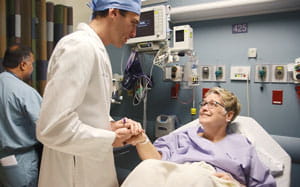3D-Printed Ankle Replacement Helps Nancy Walk Confidently Again
Her family noticed it right away. Nancy Hauser, 59, of Williamsport, was walking confidently on the beach and into the surf. As she navigated the uneven terrain, with sand shifting beneath her toes and waves breaking at her knees, her left foot moved up, down and to the side, helping her maintain balance with no pain or assistance. She was effortlessly enjoying a vacation with her extended family, and that’s an achievement she doesn’t take for granted. What made it possible was an 8-cm extension for her left fibula, a bone in her ankle, created with a 3D printer.
In February 2017, Nancy received the world’s first ever ankle replacement post fusion using a fibula created by a 3D printer. The procedure was performed by Zachary Ritter, DPM, of Foot & Ankle Specialty Care at UPMC, who has been working with the concept since his residency in reconstructive foot and ankle surgery at St. Luke’s Hospital and Health System in 2009. When 3D printing technology advanced to support his designs, he asked Nancy if she would try an innovative procedure that could restore use of her left ankle.
An Early Christmas Gift

“He called me just around Christmas time and said, ‘I feel just like Santa Claus. I found a vendor who can give you a new fibula. We can give you a new ankle,’” says Nancy.
The fibula is the narrow calf bone on the outside of the leg. It is part of a network of lower leg and foot bones that are hinged by the ankle joint to enable the foot to move up and down, turn side to side and tilt. A piece of Nancy’s fibula was removed nearly a decade ago so that her foot and lower leg bones could be fused together — standard treatment at the time to address pain from a severe ankle break.
After the fusion, the permanent angle of her ankle created problems. She had a perpetual limp and her toes were always lower than her heel, causing her to trip and fall frequently. Uneven terrain and inclines were challenging to navigate, and she worried that, as she got older, falling would lead to more broken bones. The fusion also forced her to step down on her toes rather than her heel, which was causing pain in the front of her foot.
Nancy met with Dr. Ritter about her concerns shortly after he began his practice with UPMC a few years ago. Although the shortened fibula prevented him from helping her at the time, he mentioned that if he could find a company to make a prosthetic fibula, he could reverse her fusion procedure with an ankle replacement. Dr. Ritter added Nancy’s case to a file he’d been keeping since his residency when he encountered patients with similar problems. In the fall of 2016, he found a company with the ability to generate the artificial bone.
From Concept to Reality

“3D printing is a big thing across medicine now. I was working with this vendor in Germany on another project and approached them about creating a prosthetic fibula. Things started rolling from there,” says Dr. Ritter.
Nancy didn’t hesitate to agree to be Dr. Ritter’s first 3D ankle replacement patient.
“I trust him; he’s just that kind of guy,” says Nancy. “He explained exactly what he planned to do and that if the prosthetic didn’t work, the worst-case scenario would be to fuse my ankle again with a more natural placement for my foot that would eliminate the biggest problems. I figured someone had to be first, why not me?”
A CT (computed tomography) scan of Nancy’s right ankle was used to create a mirror image of her fibula for the left side. Dr. Ritter and his colleague, Christine Nolan, DPM, worked on designs for both the procedure and the prosthetic and sent them to Additive Orthopedics, LLC, where the 8-by-2-cm artificial bone was generated.
“To my knowledge, this is the first one [3D ankle replacement] that has ever been done. While ankle replacements are pretty commonplace, inserting the prosthetic fibula is the novel part. We went through an extensive approval process and institutional review with the hospital to prepare,” says Dr. Ritter.
During the procedure, he inserted the 3D extension for her fibula and two additional parts typically used for ankle replacement. He extended Nancy’s Achilles tendon through the hollow prosthetic to complete her new ankle.
Nancy, who has also had two knee replacement surgeries in the last 10 years, says her initial recovery was challenging, but she worked persistently with her physical therapists and on her own to improve her flexibility and strength. At just under six months, she hadn’t fallen at all and much of the stiffness and discomfort was gone. Her fused ankle had limited her ability to be as active as she would like, and now she could routinely walk with her grandsons, who ride their bicycles behind her.
Bowling, the Beach, and More

Nancy assumed her next big milestone would be getting back into UPMC's bowling league with her husband, daughter, and grandson after the six-month recovery mark in September. But at the beach with her family in August, she felt certain she had turned another corner in her recovery.
“Everyone in my family noticed that I was getting around really well. I haven’t been able to walk on the beach like this without pain or out into the surf without help for at least 10 years. I would fall face down in the sand because of my ankle,” she says. “It’s so much better than I thought it would be.”
Having a first-of-its-kind procedure close to home was a benefit for Nancy, too, especially with two presurgery and four follow-up visits.
“I’m just really happy and thankful for this. It is making a big difference,” she says.
Dr. Ritter is pleased, too, stating that Nancy’s results are already better than he hoped and may continue to improve over the next few months. After one year of follow up, Dr. Ritter can publish a paper regarding the procedure that will give other surgeons the opportunity to expand upon the innovative work he has done. Reaching this long-term goal to provide an option for patients who were previously limited in their mobility and quality of life by ankle fusion is gratifying to Dr. Ritter.
“It is a little surreal to me that here in Williamsport we have performed a procedure that hasn’t been done anywhere in the world,” says Dr. Ritter. “It’s really a credit to the health system for supporting our ideas and our practice, and, of course, Nancy for willingly being the first. It all just came together so well,” he adds.



















